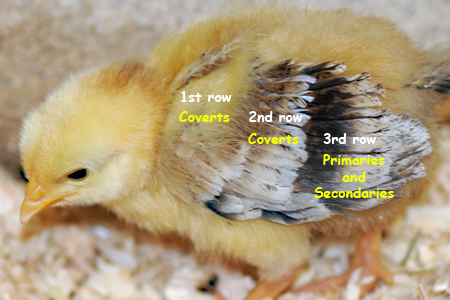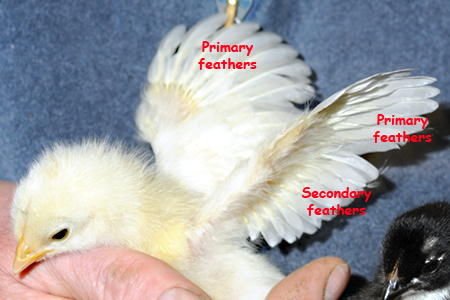Welcome to Relaxed Farming
- Alpacas
- Chickens
- Dairy Goats
- Ducks
- Geese
- Pigs
- Pygmy Goats
- Quail
- Rabbits
- Sheep
- Turkeys
- Polytunnel
- Photo Stories
- Video Stories
- Food
- Smallholding Map
- 2013
- 2014


- August
- September
- October
- November
- December
- January
- February
- March
- April
- May
- June
- July
- August


- 1
- 2
- 3
- 4
- 5
- 6
- 7
- 8
- 9
- 10
- 11
- 12
- 13
- 14
- 15
- 16
- 17
- 18
- 19
- 20
- 21
- 22
- 23
- 24
- 25
- 26
- 27
- 28
- 29
- 30
- 31
Tuesday, 15th April 2014
Our young chicks are really starting to develop their wing feathers - these first appear when the chick is just four-five days old and are the first 'real' feathers to start to grow. As you can see from the photos the rest of the chick is still fluff or 'down'. The wing of an adult bird is quiet complex with SEVEN different types of feathers and in these chicks (aged 12 and 10 days respectively) you can clearly see the different types already growing.
The first thing to notice is that there are three rows of feathers; the chick with the brown wings is the best one to look at to see this. The first row nearest the head still has a fair few down feathers but the second and third rows look a lot more like proper feathers. In addition each row is made up of two different types which you can see in the yellow winged chick. In this chick the feathers furthest away from the body in the third row are called primaries and it is these feathers that really help a bird to fly (and these are what we cut when we clip a bird's wing to STOP it flying!!). The secondary feathers make up the rest of the feathers in this third row.
Most of the remaining feathers on the wing are called 'coverts' as they 'cover' the rest of the wing. As our chicks get older more and more feathers grow to cover the rest of their body but the down feathers remain underneath as these help to keep the bird warm. Many domesticated chickens now are not great flyers as their bodies have changed with breeding and often many are too heavy to fly. They still use their wings when they run around though as flapping them can help them run faster and they also use them when they want to jump/fly up on their perches for the night. It is fascinating watching the feathers develop on our chicks and see the different colours start to come through. Some are beginning to look very pretty indeed.

